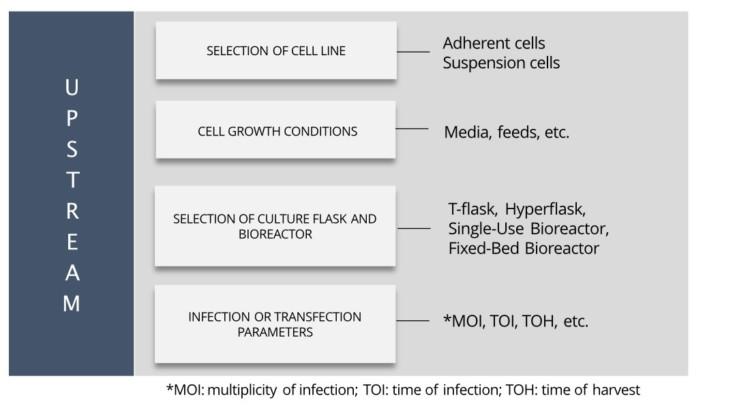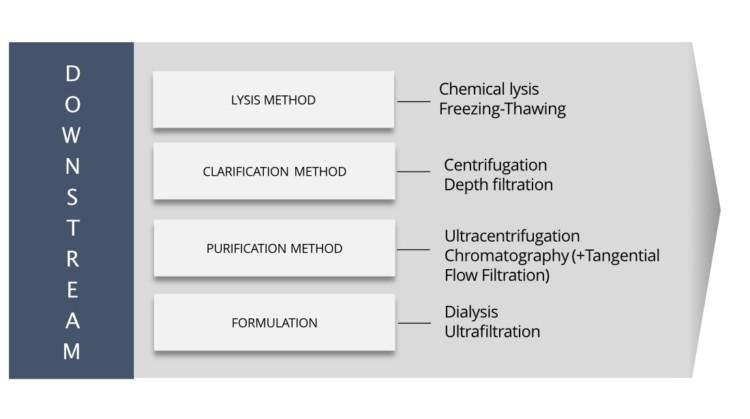Viral Vector process development explained – from Upstream to Downstream
A conversation with Pirjo Merilahti, PhD., Virology.

At Biovian, Viral Vector process development is planned and executed by a team of experienced scientists, led by Dr Pirjo Merilahti. Her team typically starts the project with the selection of production methods, analytical methods and process parameters, which all need to be tested and optimized. The objective of their work is clear – to establish a robust and cost-effective Viral Vector manufacturing process that allows the project to move from the small laboratory scale into the large production scale, according to the GMP regulations.
In this blog Process Development Manager of Biovian, Pirjo Merilahti, who holds a PhD. in Virology, explains how her team brings client Viral Vector projects from the laboratory bench to the clinic.
Cell Banks, Virus Seed Stocks and Plasmid DNA
“In order to get started with Viral Vector Process Development, cell banks will be needed,” Dr Merilahti says. “Cell banks can be prepared by Biovian as a first step if they are not readily available from the client.”
Dr Merilahti explains that the starting material for Process Development can be either a Research Cell Bank (RCB) or a Master Cell Bank (MCB) – the latter is a well-characterized version of the same cell line as RCB. Similarly, Virus Seed Stocks needed for infection or Plasmids needed for the transfection of host cells can be either client-supplied or prepared by Biovian from the starting material obtained from the client.
“To give an example, an oncolytic Adenovirus Vector project requires either a Research Virus Seed Stock (RVSS) or a Master Virus Seed Stock (MVSS), whereas an Adeno-Associated Viral Vector (AAV) project may require three types of plasmids to build functional AAVs”.
“The building of Viral Vector processes from almost any starting point is the expertise of Biovian. Our Process Development team can start the Viral Vector project from a single vial of virus or a small volume of plasmids. Alternatively, we can start from a heterogeneous virus population – in this case, our first step is to prepare a homogeneous virus batch by plaque purification and confirm that the virus contains the desired features,” Dr Merilahti explains.
Process Development – Upstream processes
The Viral Vector Upstream Processes include the thawing of cells, cell expansion, infection with virus seed or transfection with plasmids, and culturing of the Viral Vector producing cells.
“First the cells (RCB or MCB) are thawed, followed by cell expansion in culture flasks. Cell expansion means that the number of cells will be increased, either by transferring the culture to a bigger flask and volume, or by increasing the number of culture flasks,” Dr Merilahti explains. “Suspension cells are cultured and expanded in shake flasks. For adherent cells flasks such as T-flasks, HYPERFlasks and HYPERStacks are among the choices.”

According to Dr Merilahti, the determination of the optimal parameters for the virus infection or plasmid transfection is of utmost importance. She brings up a few virus-infection-related critical parameters such as multiplicity of infection (MOI), which is the number of virions added per cell during infection, time of infection (TOI) and time of harvest (TOH), which are routinely determined by her process development team.
“These Upstream Process parameters are crucial in predicting the yield of Viral Vectors,” Dr Merilahti says. “This systematic approach to uncovering the cause-and-effect relationships between process input and output is called Design of Experiments (DoE). In practice, DoE influences the quantity and quality of Viral Vectors.”
Flask culture vs Bioreactors
“Typically, we start process development with a small-scale flask culture and determine the optimal parameters and then proceed with bioreactors,” Dr Merilahti tells. “We also have projects where Viral Vector flask cultures have been scaled to GMP production by adding more culture flasks to increase capacity. This may be an option for clients, who need to demonstrate successful clinical phase I results, before sponsors can make more funding available.”
However, it is a well-known fact that a bioreactor provides a more controlled culture environment than flasks, with minimal batch-to-batch variability, low contamination rate and lower operation costs. So, if the project is well funded from the start, would not the early use of bioreactors be the best option for the project’s future?
“It would,” says Dr Merilahti. “The state-of-the-art approach to Viral Vector process development is indeed to use flask-cultured cells to inoculate a bioreactor and to proceed from there. Adherent cells can be cultured in a disposable packed-bed bioreactor, such as iCELLis® Nano, or in a single-use bioreactor using microcarriers. Suspension cells can be cultured in a Wave bioreactor or a stirred-tank reactor such as Xcellerex™ XDR-10, to name a few. The great benefit of our range of bioreactors is that they can be scaled up to similar larger volume systems. This makes upscaling from laboratory scale to production scale straight-forward,” she points out. “However, as an experienced CDMO we understand that client projects have different needs – whatever the need, Biovian has the equipment and knowledge to help out,” Dr Merilahti clarifies. “This is what we call truly personalized contract manufacturing.”
Process Development – Downstream Processes
Where to draw the line between Upstream and Downstream processes? There is no exact answer to this question if you look at the spread of opinions within the Viral Vector manufacturing industry. Cell lysis and clarification are the two obvious steps that link the Up- and Downstream Processes, and they are sometimes called Midstream Processes. Regardless of the definition, the role of Downstream Processes is to enrich the Viral Vector product while eliminating contaminants that originate from host cells and the culture medium.

Dr Merilahti explains that the Viral Vectors reside either inside the cells or both inside the cells and in the culture media. “To release the intracellular viruses the cultured host cells are disrupted either using chemical lysis or through freezing and thawing. The composition of the chemical lysis buffer depends on the type of culture. Freezing and thawing may be chosen as the lysis method if the goal is to specifically collect viruses that are inside the cells. Nuclease enzymes are often added during or after cell lysis to digest residual nucleic acids from the host producer cells and plasmid DNA. The subsequent removal of cellular debris from the viral supernatants is called clarification and it can be done for example using depth filtration.”
Ultracentrifugation vs Chromatographic purification
The selection of the purification method for the Viral Vector harvest further depends on variables such as the cell line and the nature of the virus, as well as on the harvest method and volume.
“Ultracentrifugation is an effective method for the purification of e.g. adenovirus vector or AAV in small scale,” Dr Merilahti says. “Here the number of centrifugation rounds that are critical for the desired viral titer and purity needs to be optimized. At the moment, ultracentrifugation is the easiest method for removal of empty viral capsids, the virus particles without the genome, but it is worth pointing out that although ultracentrifugation is a fast method for Viral Vector purification, its scalability is limited.”
So, what is the solution for large-scale Viral Vector purification?
“Chromatographic purification,” says Dr Merilahti. “It is easier to scale up chromatographic purification from the laboratory to manufacturing, and therefore it is the method of choice in many client projects that my team takes care of. Biovian’s laboratory-scale chromatographic purification and Tangential Flow Filtration (TFF) scale up to fully automated systems, when moving into GMP production scale.”
The optimization of the chromatographic purification of Viral Vectors is performed during process development. “As an example,” Dr Merilahti says, “a typical adenovirus vector project may include several consecutive purification methods such as Ion Exchange Chromatography (IEX), Hydrophobic Interaction Chromatography (HIC), TFF and size-exclusion chromatography (SEC), which all need optimization. It may sound like a lengthy process, but at Biovian with the expertise, experience and especially with all systems in place, everything is fast-moving,” she concludes.
Process development – Analytics and in-process control
Analytical methods are needed for raw material testing, in-process control and for demonstrating the quality of the Viral Vector batch. GMP Viral Vector batches that are manufactured for clinical trials must comply with an increasing number of global regulations. Safety, identity, strength, purity and quality are among the items that need to be demonstrated [1].
Dr Merilahti emphasizes that Viral Vector analytics are fully integrated with process development during all Drug Substance and Drug Product development projects at Biovian.
“Viral Vector analytics demand a set of expertise, a clear understanding of both GMP and ATMP regulations, and that standard operating procedures (SOPs) are in place [2,3,4]. Considering the fast-paced timelines of Viral Vector projects, comprehensive analytical services during all Drug Substance and Drug Product development projects are of great help to our clients. We provide our clients with full access to process analytics. When working with us, the clients do not have to shop around or make a huge effort to set up Viral Vector analytics themselves. That is the essence of our One-Stop-Shop service concept,” Dr Merilahti says.
Process development – the human element
“I am very proud of my process development team,” Dr Pirjo Merilahti says with a smile. “I believe that an excellent CDMO needs up-to-date equipment and facilities, but to make it really great you also need truly experienced and dedicated people. The Process Development people at Biovian have this amazing ability to combine their innovative scientific minds with the rigid requirements of GMP production. If I was asked to summarize our process development services into a slogan, it would be something like: “flexibility and quick response without compromising quality”. With this, I refer to our ability to take actions on short notice and to react to changing circumstances, while always operating with premium quality and on the client’s terms.”
Summary
A range of expertise is needed to master the interplay between Viral Vector production and applicable global regulations. In this blog, Dr Merilahti from Biovian has explained the aspects that must be taken into consideration during the laboratory scale in order to make a smooth transition into GMP production scale and clinical trial use. Here collaboration with an experienced process development team can make the difference between success and failure. An expert team can select the most suitable methods as well as determine the parameters for Upstream and Downstream processes and analytics that are needed for optimized and regulatory compliant Viral Vector production.

References:
- ICHG GLC, “Essential documents for the conduct of a clinical trial. https://ichgcp.net/8-essential-documents-for-the-conduct-of-a-clinical-trial
- Guidelines relevant for advanced therapy medicinal products. https://www.ema.europa.eu/en/human-regulatory/research-development/advanced-therapies/guidelines-relevant-advanced-therapy-medicinal-products
- Cellular & Gene Therapy Guidances. https://www.fda.gov/vaccines-blood-biologics/biologics-guidances/cellular-gene-therapy-guidances
- EudraLex The Rules Governing Medicinal Products in the European Union, Volume 4 Good Manufacturing Practice. https://ec.europa.eu/health/sites/health/files/files/eudralex/vol-4/2017_11_22_guidelines_gmp_for_atmps.pdf


